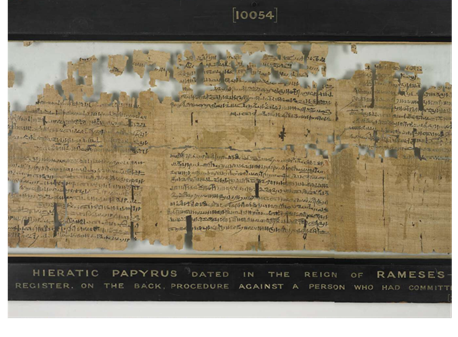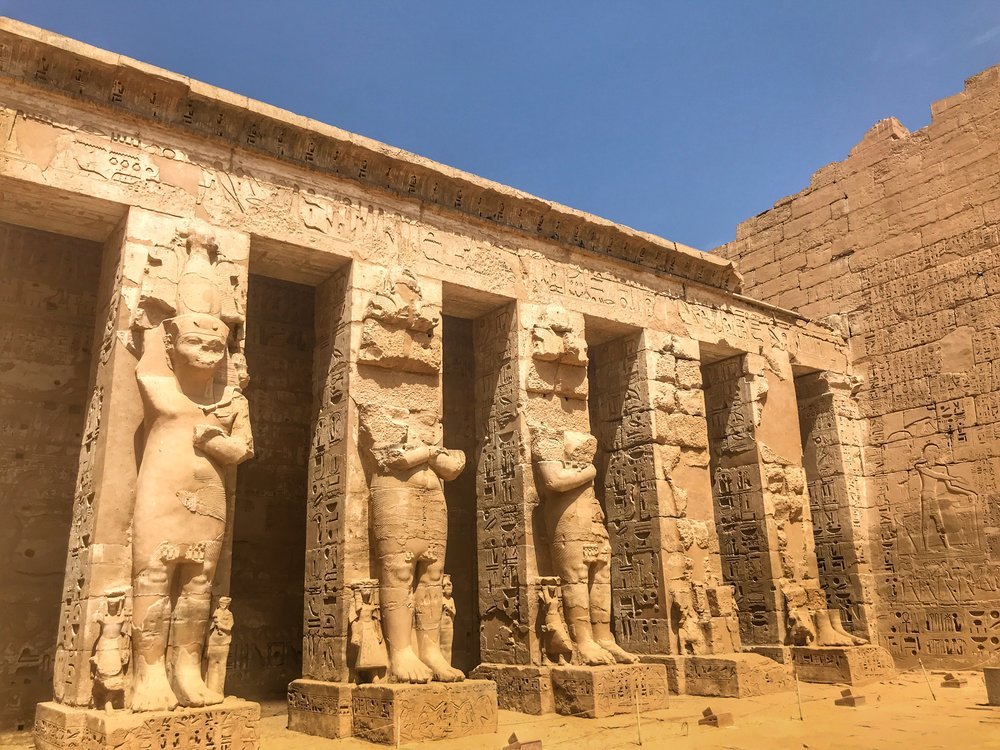Tomb robbery in Ancient Egypt went through many phases, largely dependent on the economic position of the state at a given point in time. The more elaborate tombs which are found complete or near-complete today are usually those which have been hidden well and kept a secret by their makers, but the majority of high-profile tombs are discovered in a modern context with much missing or vandalised.
Tomb robbery was not only an activity for the poor and desperate in Egypt. Indeed, in the Twentieth and Twenty-First Dynasties (from the twelfth to the tenth centuries BCE), it was often the families of the buried who stole from their tombs, and – in some cases – items were robbed before the mummy was interred, when bodies were still in the embalming workshops. Therefore, when you consider the Tomb Robbery Papyri, a significant collection of documents concerning the tomb robberies of the Twentieth Dynasty recorded in the reign of Rameses IX, it is clear that a double standard existed. Harsh reactions to individual robberies are likely related to whether the incident was a citizen’s planned raid on a royal resting place, or a robbery of a family member’s tomb.

The Tomb Robbery Papyri contain a wealth of information on the treatment of tomb robberies during the Twentieth Dynasty, and the papyrus BM EA10054, (fig. 1) translated by T. Eric Peet, provides a detailed example of how tomb robberies were carried out and investigated. Also known as the Harris papyrus, this object was donated to the British Museum, alongside numerous papyri from the collection of Mr Anthony Harris, by Selina Harris, his daughter. Measuring 116cm in length and 41cm in width, with an additional loose 10cm, the papyrus contains multiple separate texts, with the most relevant to this discussion being those found on verso p.1 and recto p.1. These sections outline the examination of Amenpnūfer, a quarryman who, following a ‘beating with the stick’, details his involvement with the robbery of tombs to the west of Thebes, and goes on to be punished harshly, alongside his fellow robbers. Taking place on the 14th of the Third Inundation month within the 16th year of the reign of Ramesses IX, this examination is an indication of the changing attitudes towards burial practices occurring in the late New Kingdom.
When comparing tomb documentation of the Nineteenth Dynasty with that of the Twentieth Dynasty, Kathlyn Cooney notes that there are less tomb commissions. This is perhaps a reflection of the social and economic upheaval which was occurring around the end of the Bronze Age both in Egypt and around the Mediterranean. With prices increasing exponentially, and workers going unpaid, there was a necessary shift away from lavish burial practices. Tomb robberies, in this economic context, were a way of re-introducing commodities into the market, items which had been removed from the economic sphere to serve purely religious functions, yet which still carried immense monetary value. These were items such as canopic jars, pieces of jewellery, amulets and other material goods which were deemed – particularly in the earlier New Kingdom – to serve as essential items for the deceased in the afterlife. The removal of any of these goods, especially when considering the religious attachments which accompanied them, marks a significant shift in attitudes towards burial.
If an increase in tomb-robbing is not an indication of societal religious changes – which it doesn’t appear to be – it can instead be seen as indicative of a level of financial desperation, the kind that induced turning to family members’ burials for commodities. Changing burial patterns within the Twenty-First Dynasty saw burials being made remarkably simpler, whilst still ensuring that the deceased individual had value to show in their journey to the afterlife. This is perhaps why the mummification process becomes so much more complex during the Twenty-First Dynasty. Before this point, the embalming process was relatively simple, with little effort to restore the body in a way that would make it recognisable to friends and family. However, during the Twenty-First Dynasty a trend was established whereby the face would be reconstructed on the deceased’s body and oftentimes the abdomen would be stuffed following the removal of organs, in order to make the deceased appear more alive. It has been theorised that this change is connected to the trend of tomb robbery, as it commodifies the body itself, rather than placing emphasis on material goods which might later be removed. In this way, monetary value is instilled into the body which cannot be broken down and sold, unlike other items involved in a burial.
One of the most common things to be stolen from tombs was the gold or copper from the coffins themselves. This is referenced within the Harris papyrus when Amenpnūfer admits: ‘we stripped off their gold and silver which was on them [and we] stole it.’ This is something that is relatively easy to steal from tombs, and quite easy to pass off as a commodity and sell without having to worry about questions surrounding the origin of materials. Stripping coffins of their gold and silver was not a trend limited to ‘professional’ tomb robbers, and it was also common for more ‘amateur’ robbers who were only seeking a small profit. In reaction to increased robberies, especially of elite graves, many elites began to bury their dead in group settings to increase the chances that their deceased would remain intact. They did this through hiring security, paying for more concealed plots of land, and paying off those who worked on the tomb in order to lower the chances of information spreading. The issue with this is that many robberies were not large affairs but could take place when another body was being interred in the group tomb, with workers chiselling gold and silver from previous burials that were hidden by the new coffin. This indicates that not only was tomb robbery for those who had elaborate plans and teams, or even for family members of the deceased, but could also include workers in the funerary businesses. Perhaps the pervasiveness of tomb robbing culture is indicative of just how desperate the economic crises of the late New Kingdom Dynasties were.
Tomb robberies are perhaps one of the more notorious aspects of Ancient Egyptian culture now spoken about within the popular sphere, and the importance which is placed on finding whole burial sites can sometimes be overstated. However, there are many things which can be learned about wider society by looking both at tombs which have been robbed, and the contemporary records surrounding tomb robbery. Especially for the Twentieth and Twenty-First Dynasties, tomb robberies can give insight into the economic status of the country, as well as attitudes toward religion and rituals surrounding the afterlife. The emphasis placed on religion by people, elites, and royals within the New Kingdom and later indicates that willingness to rob tombs of family members is especially significant. Objects within burial contexts were intended for the deceased individual and were seen to be beneficial for their future after death, and thus re-commodifying these items is an action with enormous significance. This attitude was also extended to state-led mining of tombs for burial goods from the end of the Twentieth Dynasty, covering such high-profile tombs as the Valley of the Kings, with the commodities found often used in subsequent royal burials. Therefore, it is clear that tomb robbery became commonplace when Egypt’s economy was in a state of crisis, and yet there were certain forms of robbery which were more socially acceptable than others.
Written by Alice Goodwin
Bibliography
Blakesley, Charlotte, Courtroom Pragmatics: Analysis of Questions and Answers in the Tomb Robbery Papyri, (ProQuest Dissertations, 2006).
BM EA10054, Papyrus; Hieratic text. A testimony of a number of tomb robbers, digital photograph, British Museum, accessed 16th February 2021 <https://www.britishmuseum.org/collection/object/Y_EA10054>.
Cooney, Kathlyn M, “Changing Burial Practices at the End of the New Kingdom: Defensive Adaptations in Tomb Commissions, Coffin Commissions, Coffin Decoration, and Mummification”, Journal of the American Research Center in Egypt 47 (2011), 3-44.
Grajetzki, Wolfram, Burial Customs in Ancient Egypt: Life in Death for Rich and Poor. (London: Duckworth Egyptology, 2003).
Ikram, Salima, and Aidan Dodson, The Mummy in Ancient Egypt: Equipping the Dead for Eternity. (London: Thames & Hudson, 1998).
Peet, T. Eric, The Great Tomb Robberies of the Twentieth Egyptian Dynasty, (Oxford University Press, 1930).


2 responses to “Tomb Robbery in Twentieth and Twenty-First Dynasty Egypt”
[…] a few were willing to tamper with the process in order to enrich their lives on Earth. It has been argued, in fact, that tomb robbers played a fundamental role of the functioning of the ancient Egyptian […]
LikeLike
[…] Looting has always been a problem in Egypt, even in ancient times. Large quantities of gold and other precious materials lying underground in tombs is a temptation for any desperate or enterprising thief. Ancient Egyptians who were wealthy enough even designed their tombs to keep robbers out, but the long deep shafts seen in pharaonic burials often weren’t enough to keep them at bay. Many archaeological sites were rediscovered in modern times stripped of most of their valuables. Poverty, in modern or ancient times, has always been a powerful motivator in these thefts. […]
LikeLike